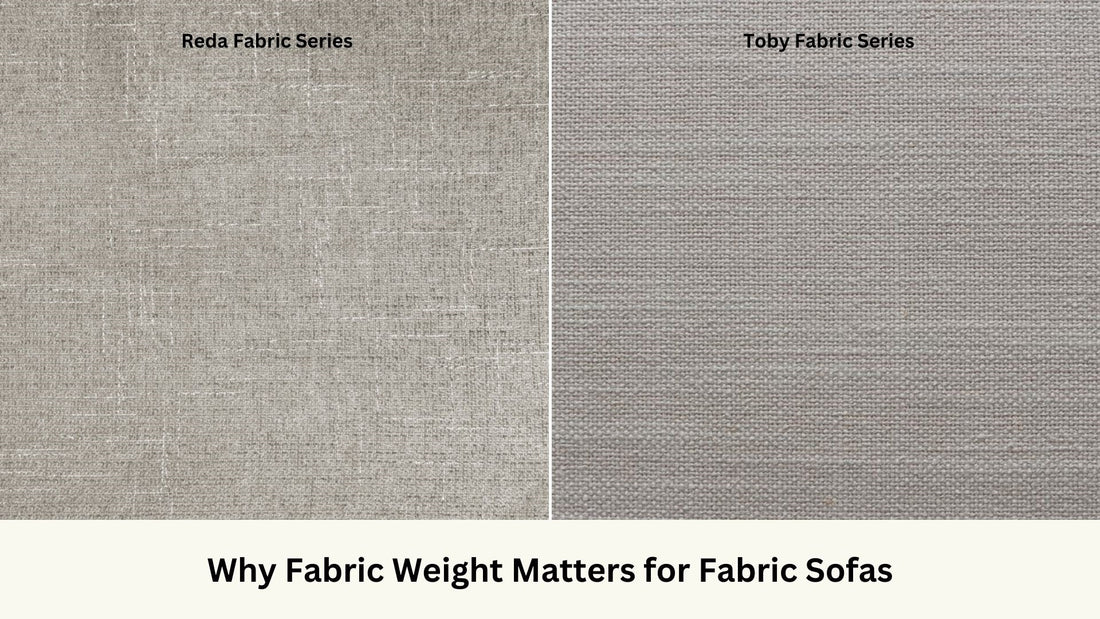
Why Fabric Weight Matters for Fabric Sofas
Share
How is Fabric Weight Measured?
Fabric weight is measured in grams per square meter (gsm), a unit that indicates how much one square meter of fabric weighs. This metric helps determine the fabric’s thickness and density. A higher gsm means a denser, heavier fabric, while a lower gsm indicates a lighter fabric. When selecting fabric for your sofa, understanding gsm is crucial for choosing the right balance of durability, comfort, and style.
Different Weight Categories and the Types of Fabrics They Represent
Fabrics used for sofas can be classified into three categories: lightweight, medium weight, and heavyweight. Each category offers distinct features suited for different levels of use and aesthetics.
-
Lightweight Fabrics (100-200 gsm): These fabrics include lightweight cotton, linen, and rayon. They are soft, breathable, and create a relaxed, casual look. However, lightweight fabrics tend to be less durable and may wear out faster, especially with heavy use. They are best suited for decorative elements like cushions and throws, rather than everyday sofa upholstery.
-
Medium Weight Fabrics (200-350 gsm): Fabrics like cotton blends, polyester, and velvet fall into this category. Medium-weight fabrics offer a balanced combination of comfort and durability, making them ideal for sofas that see regular use. These fabrics hold up well under moderate traffic and provide a good mix of softness and sturdiness.
-
Heavyweight Fabrics (350-600+ gsm): Thick and tightly woven cotton or polyester fabrics make up this heavyweight category. These fabrics are extremely durable and able to withstand frequent use, making them perfect for high-traffic areas or homes with pets and children. Their dense construction enhances longevity, though they may feel stiffer and less breathable than lighter options. This makes heavyweight fabrics great for sofas that need to maintain their shape and resist wear and tear over time.
How GSM Affects the Fabric
The gsm of a fabric impacts several key characteristics, including thickness, durability, feel, drape, breathability, and absorbency. Understanding how these elements change with fabric weight can help you choose the perfect material for your sofa.
-
Thickness: As gsm increases, so does the fabric’s thickness. Heavier fabrics with higher gsm provide more structure to your sofa, making it more resilient to sagging and maintaining its shape over time.
-
Durability: Higher gsm fabrics are generally more durable, making them better suited for high-traffic areas. They withstand friction, wear, and everyday use better than lighter fabrics. However, durability also depends on other factors like fiber composition, weave, and the finishing applied to the fabric.
-
Feel and Drape: Lightweight fabrics offer a softer feel and tend to drape naturally, creating a relaxed appearance. Heavier fabrics, on the other hand, have a more structured, fitted look. The stiffer nature of heavyweight fabrics lends itself to a polished and tailored appearance for your sofa.
-
Breathability: Sofas upholstered with lightweight fabrics are more breathable, allowing air to pass through and keeping the sofa cooler in warmer climates. Heavier fabrics, because of their density, are less breathable and can trap heat, making them less comfortable in hot environments.
-
Absorbency: Heavier fabrics tend to be more absorbent due to their thickness. This may offer more comfort but can also present challenges when it comes to cleaning, especially with spills. Lighter fabrics are often less absorbent and dry faster, which can be an advantage in busy households.
Misconceptions About Fabric GSM
There are several misconceptions about fabric gsm that can lead to confusion when selecting a sofa fabric. Let’s clear up some of the most common ones:
-
Heavier is Always Better: While higher gsm fabrics are more durable, that doesn’t mean they are always the best choice. Heavy fabrics can be stiffer, less breathable, and harder to clean. It’s important to balance the fabric’s weight with your sofa’s intended use and the level of comfort you want.
-
All High GSM Fabrics Are the Same: Not all high gsm fabrics behave the same. Two fabrics with identical gsm can have different textures, levels of durability, and performance based on fiber type, weave, and finishing. For instance, a 400 gsm cotton fabric may feel more comfortable and breathable than a 400 gsm polyester fabric.
-
Light Fabrics Are Less Durable: While lighter fabrics tend to wear out more quickly, durability is not solely determined by gsm. Factors such as fiber composition, weave type (knit or woven), and finishing also influence how well the fabric holds up over time. For example, a high-quality lightweight linen fabric can still be strong and long-lasting due to its fiber strength and weave.
Conclusion
Fabric weight, measured in gsm, is a critical factor in determining the performance and longevity of your sofa’s upholstery. Heavier fabrics are ideal for durability and structure, while lighter fabrics offer softness and breathability. However, gsm alone doesn’t dictate a fabric’s quality—fiber type, weave, and finishing all contribute to how well your fabric will perform. By understanding the importance of fabric weight and how it affects your sofa, you can make an informed choice that suits your lifestyle and design preferences.
Published: 19th Oct 2024
